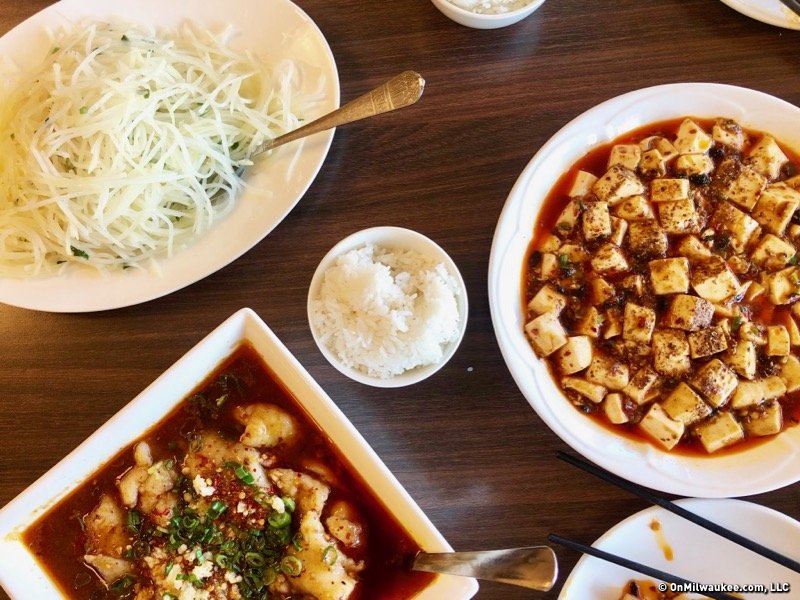Sze Chuan Restaurant
11102 W. National Ave.
(414) 885-0856
Szechuanwestallis.com
Prices: Appetizers, $2.65-$7.95; soups $4.95-$9.95; entrees, $7.95-$23.95 (most around $12-15)
What to try: Sichuan spicy pork dumplings; sliced pork belly in garlic sauce; sliced potato; Sichuan grilled lamb; steamed egg
There is an old Chinese idiom (min yi shi wei tian) which translates loosely as "Food is the god of the people" or "Food is heaven." And for lovers Chinese cuisine – particularly Sichuanese – there’s a substantial taste of paradise to be found at Sze Chuan in West Allis.

Open for just over a year, the restaurant is owned and operated by chefs Luo Shungui and Sun Yin, both of whom are from Chengdu, a province in the Sichuan region of China. And their cultural heritage and expertise are showcased in spades on the Sze Chuan menu.
While America likes to distill the flavors of Sichuan into just a few dishes, most of which employ the delightfully mouth-numbing heat of Sichuan peppercorns; it’s a true underestimation. After all, Sichuan is a region with a rich culinary tradition that employ a complex canon of sophisticated flavors ranging from salty and numbing, savory and spicy to richly sweet and engagingly sour.
It’s taken me months to work my way through just a portion of the Sze Chuan menu. For one, it’s expansive, showcasing a range of items from Chinese-American chop suey to common regional dishes including Cantonese chow fun and Hunan shrimp. I’m sure many are delicious; however, I focused my energy on Sichuan dishes, and it was a journey that came with countless rewards (and very few misses).
In terms of eating at Sze Chuan, my advice is to gather with a group of food-loving friends so that you can try more than a dish or two. Portion sizes are large, meant for communal eating, and if you eat with a group of four or more, you can easily sample a few starters, vegetables and a range of meat and seafood dishes. Alternatively, prepare to take home a substantial amount of leftovers.
Appetizers and cold dishes
Among dishes to start your meal, you’ll find numerous snackable dishes including staples like egg rolls, spring rolls and pot stickers. Don’t miss the memorable crispy scallion pancake, which is fried, but light with beautifully defined layers, and the dumplings (two are listed on the menu, but the Zhong dumplings, which I was eager to try, weren’t available on any of the days I visited).
Don’t dismay. The Sichuan pork dumplings are more than worthy, and I don’t think I made a visit without ordering them. They’re a textural feast – from their beautifully delicate slippery skins to the tender-firm pork filling – that’s pushed to the next level by a bath in chili-laden oil and punchy topping of fresh garlic and scallion. If you love heat, try one of the tiny slices of deeply flavored pickled green peppers; they’re delicious.
.jpg)
Another memorable dish is the sliced pork belly in garlic sauce, which can be found among the cold dishes. The pork is sliced ultra thin, tossed with fine shards of scallion, and coated in a beautifully salty, tangy, garlicky sauce that somehow elevates the entire dish far beyond the sum of its parts.

Hot pot, dry pot, stone pot
The hot pot option is popular, and for good reason. After all, it’s a virtual buffet of items delivered to your table, ready to be cooked in hot broth kept warm with a portable burner. If you love fondue, you’ll probably glean similar enjoyment from hot pot.
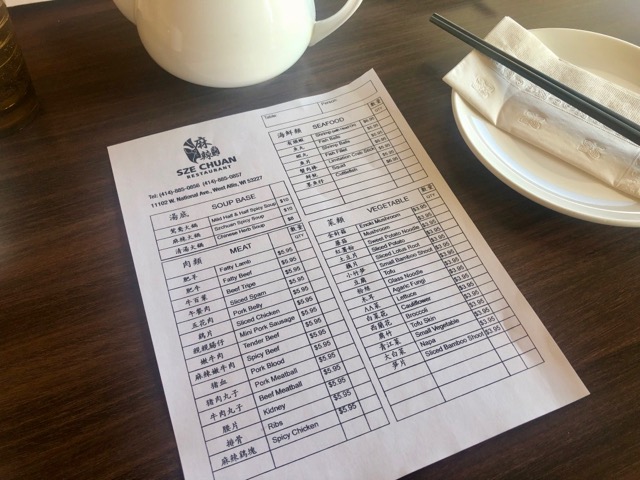
Just fill out the checklist at your table, choosing your soup base (half mild/half spicy; Sichuan spicy; or Chinese herb) as well as meats and vegetables, which run the gamut from lamb, beef and pork belly to meatballs, kidneys, shrimp, squid and cuttlefish to tofu, glass or sweet potato noodles, sliced lotus root, mushrooms, broccoli, napa cabbage and potatoes. Each item has a set charge, ranging from $3.95 to $6.95 per person, plus the cost of your broth pot ($8-10). It’s a wonderfully social way to spend an hour or two, chatting and nibbling the time away.
If you’d prefer to skip the process of cooking your own meal over hot, bubbling vats of broth, there’s redemption in dry pot dishes, which incorporate all the aromatic, flavorful spices and herbs present in hot pot broth in a dish that’s been cooked for you without broth. Options include squid, pork intestine, tea tree mushrooms, cauliflower, chicken, beef, duck wings and tofu.
The brothy, bubbling stone pots offer a similarly enjoyable experience. They feature a choice of proteins (beef, fish, chicken, tofu or pork kidney) cooked in spicy broth and delivered to your table in a screaming hot bubbling bowl of deliciousness.
Additional entrees
Despite the lure of the hot pot, I found more bliss in the long list of entrees, which includes a number of can’t-miss Sichuanese staples.
Take the mapo tofu, a classic Sichuan dish, which is all-too-often a muddy, unmemorable choice. It’s not so at Sze Chuan, where tender cubes of silken tofu are drenched in red pool of chili oil with toasted Sichuan peppercorn and fermented black beans. You can certainly opt to make the dish as spicy as you like; but ordering it medium-hot will give you a nice amount of subtle, layered heat without masking the other, more delicate flavors.

The dish nicely showcases the region’s namesake peppercorn (really a dried berry), which showcases a floral aroma and a numbing heat attributed to the presence of the hydroxy-alpha sanshool molecule. Try the dish with ground pork for a meaty boost.
On the vegetable side, you’ll do well with a variety of dishes, from sauteed string beans and garlic sauced eggplant to fresh pea tips (available in season). But don’t miss options like the mustard greens sauteed with tofu skin, which showcases the mild bitterness of the greens and the fresh, almost eggy flavor of the tofu skins.
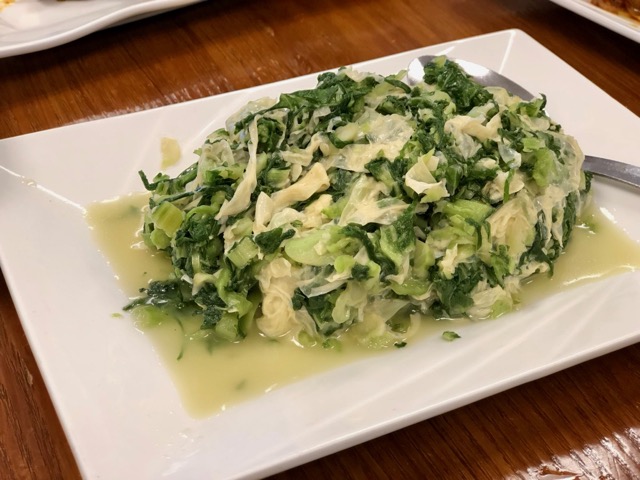
There’s also a bit of unexpected joy in the humble-yet-traditional potatoes, which are cut into thin strands and cooked just to crisp tender before being delicately bathed in vinegar.
On a slightly humorous (but not inaccurate) note, this dish has been on my "must try" list for years, ever since a well-traveled friend shared her glowing admiration for what she called the "French fries" of China.
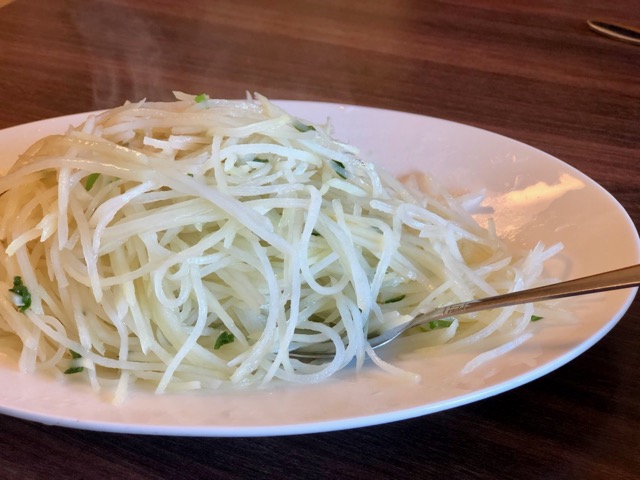
If your goal is to explore Sichuan cuisine more deeply, it’s worthwhile to check out one of the restaurant’s boiled dishes. Recommendations from our kind server included sliced beef or fish in chili pepper soup or the fei teng fish, a popular dish in Chengdu featuring tender fish presented in bowl of hot broth and topped with chili oil, dried chilies and Sichuan peppercorns.
We relished the fish in chili pepper soup, which incorporates many of the same flavors as the fei teng in a more robust, viscous sauce. The fish is tender and succulent and the sauce flavorful (and spicy; order it mild if you’d prefer to avoid some of the heat) and dappled with bean sprouts and tender bok choy.
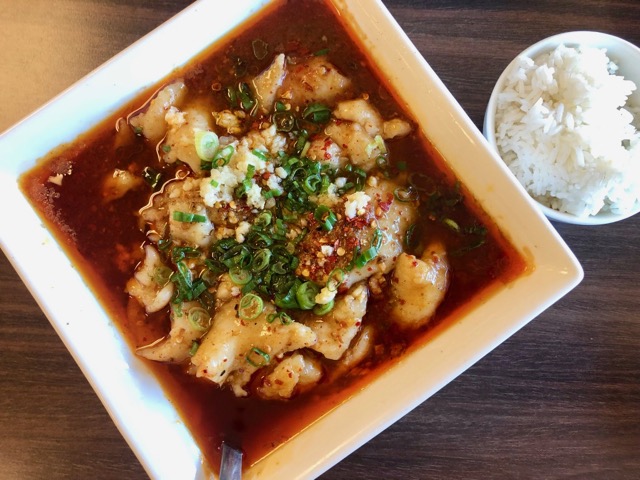
I was similarly enamored of the the Sichuan grilled lamb which features tender bites of beautifully seasoned lamb, redolent of cumin and chilies and cooked with onion and peppers. It’s a dish I’m likely to order again and again.
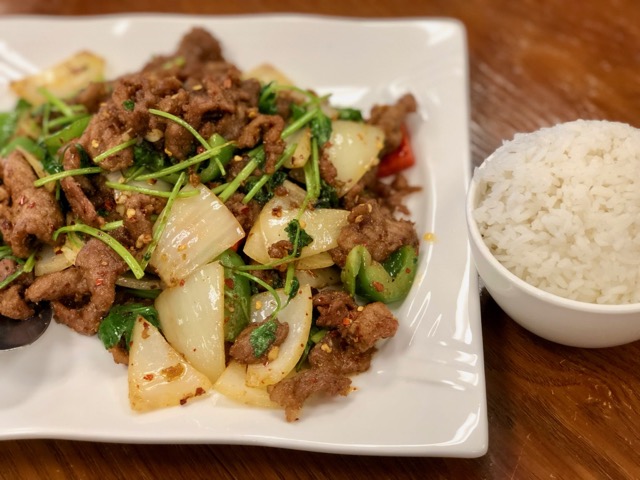
On the milder side, you’ll find twice-cooked pork, another classic Sichuan dish made with pork belly that’s first boiled, then cooled and thinly sliced before being stir-fried with sliced leeks and a complex, savory sauce comprised of fermented bean paste (doubanjiang) and sweet wheat paste (tian mian jiang). It’s salty, slightly sweet and not notably spicy.

There’s also the memorable steamed egg, a gorgeously smooth (and deceptively simple) egg custard topped with your choice of minced beef or bean sprouts. The custard itself is creamy and light with a flavor reminiscent (for me) of egg drop soup; the beef (pictured) is served in a glossy, savory sauce that’s hefty on the umami. Be warned: the dish is rich and the portion large; so enjoy with friends.

Sze Chuan is open Sunday through Thursday from 11 a.m. to 10 p.m. and Friday and Saturday from 11 a.m. to 10:30 p.m.
Lori is an avid cook whose accrual of condiments and spices is rivaled only by her cookbook collection. Her passion for the culinary industry was birthed while balancing A&W root beer mugs as a teenage carhop, fed by insatiable curiosity and fueled by the people whose stories entwine with each and every dish. She’s had the privilege of chronicling these tales via numerous media, including OnMilwaukee and in her book “Milwaukee Food.” Her work has garnered journalism awards from entities including the Milwaukee Press Club.
When she’s not eating, photographing food, writing or recording the FoodCrush podcast, you’ll find Lori seeking out adventures with her husband Paul, traveling, cooking, reading, learning, snuggling with her cats and looking for ways to make a difference.

